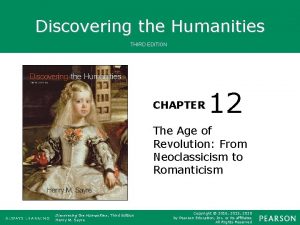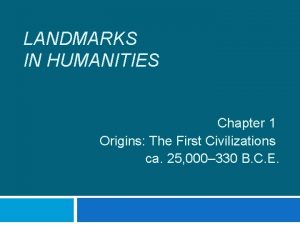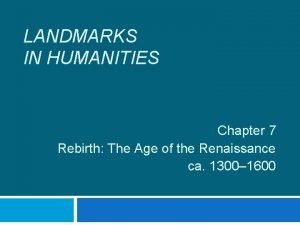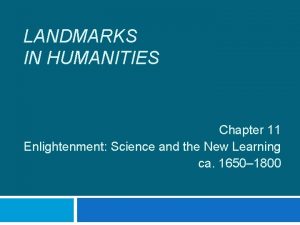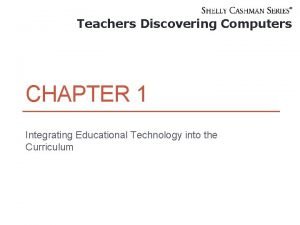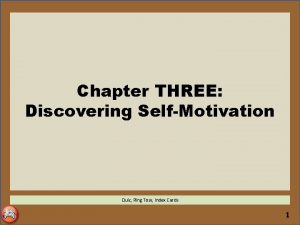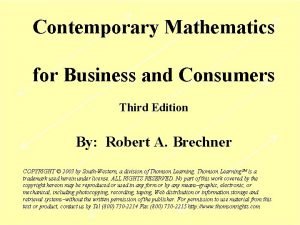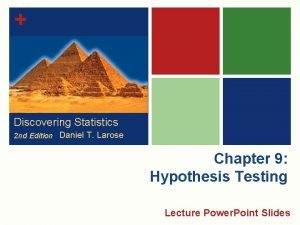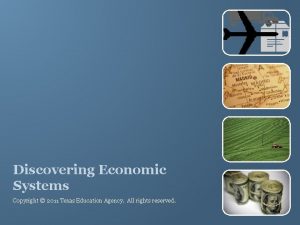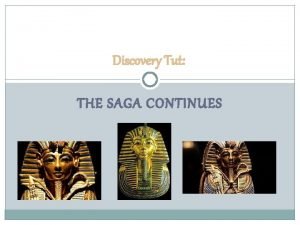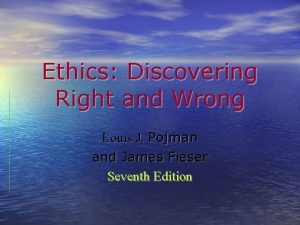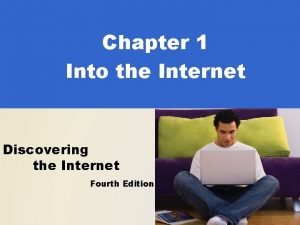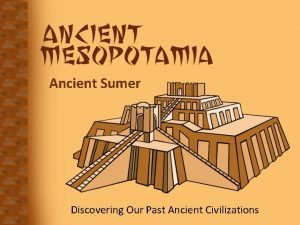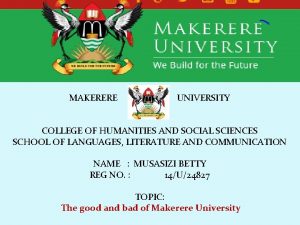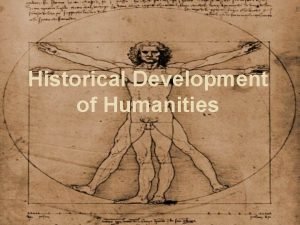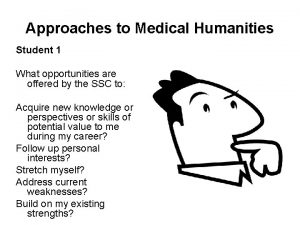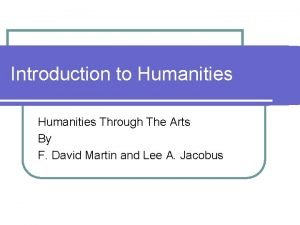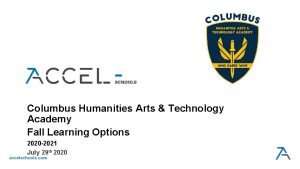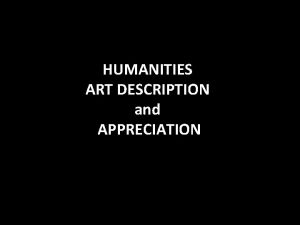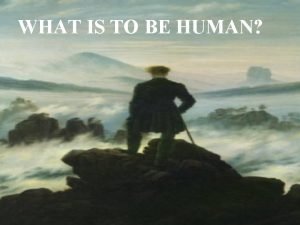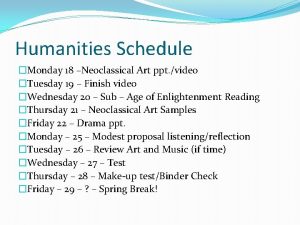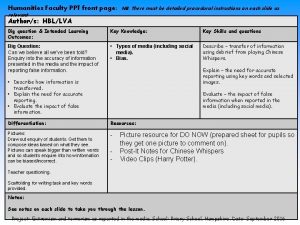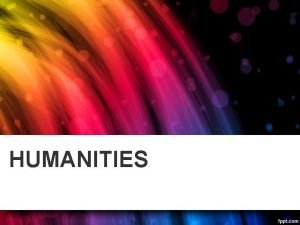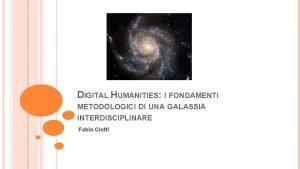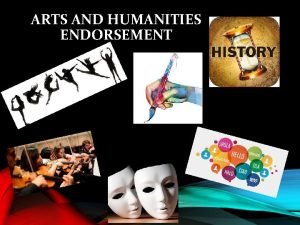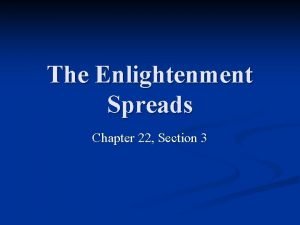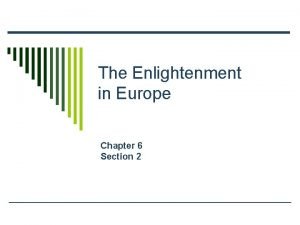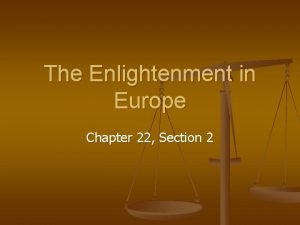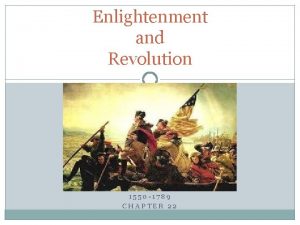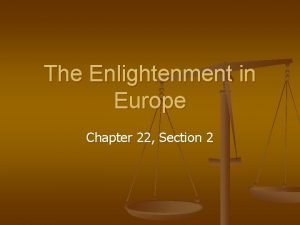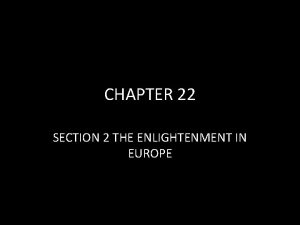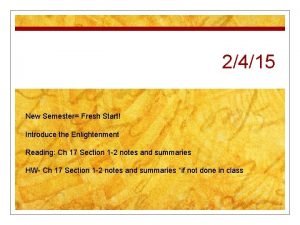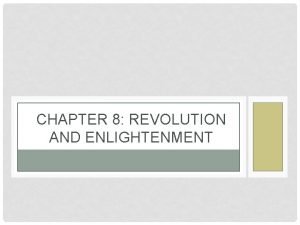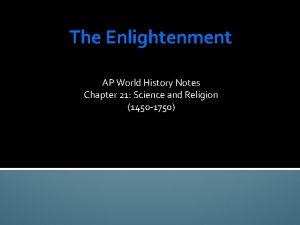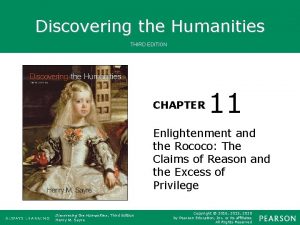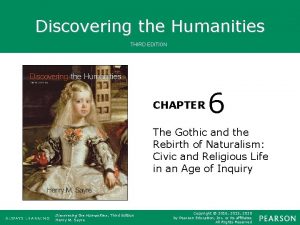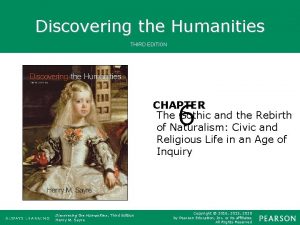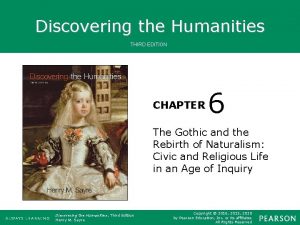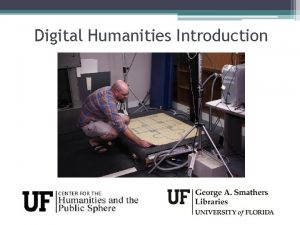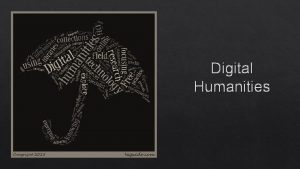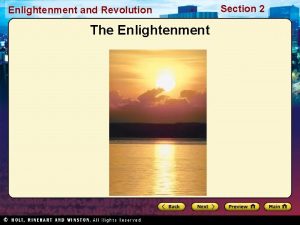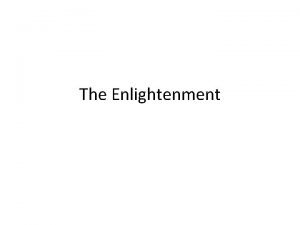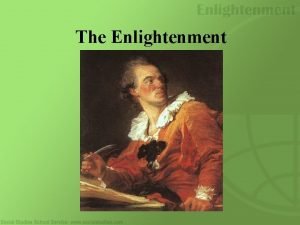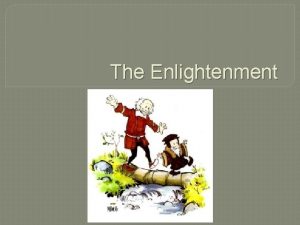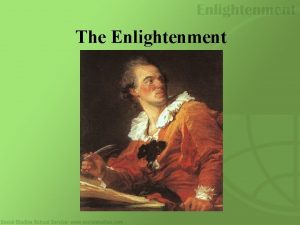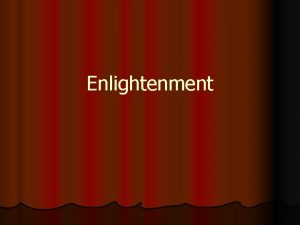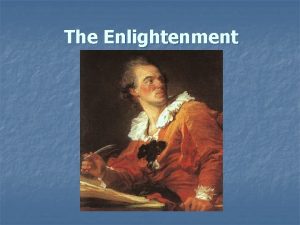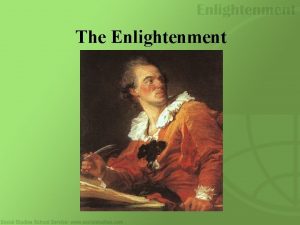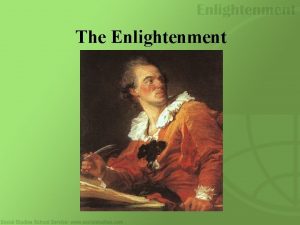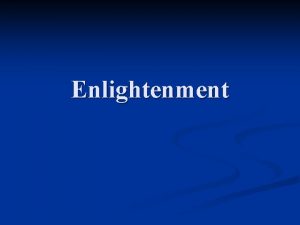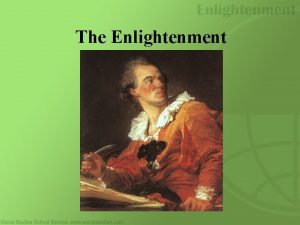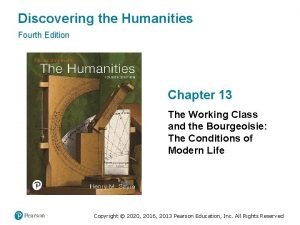Discovering the Humanities THIRD EDITION CHAPTER 11 Enlightenment





























































































- Slides: 93

Discovering the Humanities THIRD EDITION CHAPTER 11 Enlightenment and the Rococo: The Claims of Reason and the Excess of Privilege Discovering the Humanities, Third Edition Henry M. Sayre Copyright © 2016, 2013, 2010 by Pearson Education, Inc. or its affiliates All Rights Reserved

Learning Objectives 1. Discuss the role of rationalist thinking in the rise of the English Enlightenment and the literary forms to which the Enlightenment gave rise. 2. Explain the relationship of the French philosophes to both the Enlightenment and the Rococo.

Learning Objectives 3. Describe the results of cross-cultural contact between Europeans and peoples of the South Pacific and China.

Canaletto. London: The Thames and the City of London from Richmond House (detail). 1747. Oil on canvas. 44 -7/8" × 39 -3/8". Trustees of the Goodwood Collection, West Sussex, UK. [Fig. 11. 1]

The English Enlightenment • Although Christopher Wren's plans to redesign the entire London city center after the Great Fire proved impractical, requirements mandating the use of brick and stone over wood were made. • For poet John Dryden, the Great Fire was not so much a disaster as it was an opportunity to commemorate the city in his "Annus Mirabilis. "

Christopher Wren. Saint Paul's Cathedral, London, western façade. 1675– 1710. © Angelo Hornak Photo Library. [Fig. 11. 2]

The New Rationalism and the Scientific Revolution • The new London was, in part, the result of the rational empirical thinking that dominated the Western imagination in the late seventeenth century. • According to these new ways of reasoning, Scientia, the Latin word for "knowledge, " was to be found in the world, not in religious belief.

Francis Bacon and the Empirical Method • Developments in philosophy and science challenged the authority of both the Catholic and Protestant churches. • In England, Francis Bacon (1561– 1626) developed the empirical method, a process of inductive reasoning based on direct and careful observation of natural phenomena.

Francis Bacon and the Empirical Method • Bacon's writings circulated widely in Holland, where they were received with enthusiasm.

René Descartes and the Deductive Method • The French-born René Descartes (1596 – 1650) lived in Holland from 1628 to 1649. • Descartes developed a separate brand of philosophy based on deductive reasoning.

René Descartes and the Deductive Method • Deductive reasoning begins with clearly established general principles and moves from those to the establishment of particular truths. • Descartes' method has become known as Cartesian dualism.

René Descartes and the Deductive Method • His line of thinking has established Descartes as one of the most important founders of deism (from the Latin deus, "god"). • Deism is the brand of faith that argues that the basis of belief in God is reason and logic rather than revelation or tradition.

Johannes Kepler, Galileo Galilei, and the Telescope • The German mathematician Johannes Kepler (1571– 1630) collected detailed records of the movements of the planets that confirmed Copernicus' heliocentric theory. • Kepler's Italian friend Galileo Galilei (1564– 1642) substantiated theory with the help of an improved telescope.

Johannes Kepler, Galileo Galilei, and the Telescope • Kepler's and Galileo's work did not meet with universal approval. • The Catholic Church still officially believed that the earth was the center of the universe and that the sun revolved around the earth (geocentric).

Johannes Kepler, Galileo Galilei, and the Telescope • The Protestant churches were equally skeptical, since the new theories contradicted certain biblical passages. • It seemed to many that the new theories relegated humankind to a marginal space in God's plan.

Antoni van Leeuwenhoek, Robert Hooke, and the Microscope • In Holland, the microscope had been developed. • Antoni van Leeuwenhoek (1632– 1723) was able to grind a lens that magnified over 200 times.

Robert Hooke. Illustration from Micrographia: A flea. 1665. London. Courtesy the University of Virginia Library. © Photo Scala Florence/Heritage Images. [Fig. 11. 3 a]

Antoni van Leeuwenhoek, Robert Hooke, and the Microscope • Soon van Leeuwenhoek began to describe, for the first time, "little animals" —bacteria and protozoa— sperm cells, blood cells, and many other organisms.

Robert Hooke. Illustration from Micrographia: A slice of cork. 1665. London. Courtesy the University of Virginia Library. © Photo Scala Florence/Heritage Images. [Fig. 11. 3 b]

Antoni van Leeuwenhoek, Robert Hooke, and the Microscope • He regularly informed the Royal Society of London—established by Francis Bacon—about his observations. • In 1680, van Leeuwenhoek was elected full member of the Society.

Isaac Newton: The Laws of Physics • The English astronomer and mathematician Isaac Newton (1642– 1727) demonstrated to the satisfaction of almost everyone that the universe was an intelligible system, well ordered in its operations and guiding principles.

Isaac Newton: The Laws of Physics • Newton's conception of the universe as an orderly system remained unchallenged until the late nineteenth and early twentieth centuries, when the new physics of Albert Einstein and others once again transformed our understanding.

Video: Students on Site: Wright of Derby Joseph Wright. An Experiment on a Bird in the Air-Pump. 1768. Oil on canvas. 6' × 8'. © 2014 The National Gallery, London/Scala, Florence. [Fig. 11. 4]

The Industrial Revolution • A group of prominent manufacturers, inventors, and naturalists formed the Lunar Society. • The Society's members met in and around Birmingham each month on the night of the full moon—providing both light to travel home by and the name of the society.

The Industrial Revolution • The Lunar Society's members inaugurated what we think of today as the Industrial Revolution. • The term was invented in the nineteenth century to describe the radical changes in production and consumption that had transformed the world.

Architectural Simulation: Cast-Iron Construction Thomas Farnolls Pritchard. Iron Bridge, Coalbrookdale, England. 1779. Cast iron. © Graham Jordan/Adams Picture Library/Alamy [Fig. 11. 5]

Absolutism versus Liberalism: Thomas Hobbes and John Locke • English intellectuals began to advocate rational thinking as the means to achieve a comprehensive system of ethics, aesthetics, and knowledge. • Political strife inevitably raised the question of who should govern and how.

Absolutism versus Liberalism: Thomas Hobbes and John Locke • In Leviathan, the absolutist Thomas Hobbes (1588– 1679) argued that ordinary people were incapable of governing themselves and should willingly submit to the sovereignty of a supreme ruler (social contract).

Absolutism versus Liberalism: Thomas Hobbes and John Locke • The liberal John Locke (1632– 1704) argued in opposition that humans are "by nature free, equal, and independent. "

Absolutism versus Liberalism: Thomas Hobbes and John Locke • Locke's form of liberalism—literally, from the Latin, liberare, "to free"—sets the stage for the political revolutions that will dominate the Western world in the eighteenth and nineteenth centuries.

John Milton's Paradise Lost • The debate between absolutism and liberalism also informs what is arguably the greatest poem of the English seventeenth century, Paradise Lost by John Milton (1608– 1674). • Milton composed a densely plotted poem with complex character development, and rich theological reasoning.

John Milton's Paradise Lost • The subject of the epic is the Judeo. Christian story of the loss of Paradise by Adam and Eve and their descendants. • While occasionally virulently anti. Catholic, the poem is a fair-minded essay on the possibilities of liberty and justice.

Satire: Enlightenment Wit • Deeply conscious of the fact that English society fell far short of its ideals, many artists and writers turned to satire.

Satire: Enlightenment Wit • These artists and writers believed that by exposing the moral bankruptcy in society they could return England to its proper path. • They used irony and their satires are marked by deadpan humor.

Document: A Modest Proposal by Jonathan Swift William Hogarth. Gin Lane. 1751. Engraving and etching, third state. 14" × 11 -7/8". Private collection. [Fig. 11. 6]

The Satires of Jonathan Swift • Jonathan Swift (1667– 1745) was possibly the most biting satirist of the English Enlightenment. • He aimed his wit at the aristocracy and at English political leaders for their policies toward Ireland in his Modest Proposal.

The Satires of Jonathan Swift • Swift believed England was consuming the Irish young, if not literally then figuratively, sucking the lifeblood out of them by means of its oppressive economic policies.

Hogarth and the Popular Print • In Gin Lane, Hogarth turned his attention not to the promise of the English Enlightenment, but to the reality of London at its worst.

The Classical Wit of Alexander Pope • Pope spent 12 years translating Homer's Iliad and Odyssey as well as a six-volume edition of Shakespeare. • He dedicated his mock epic Dunciad to Jonathan Swift. • Published between 1732 and 1734, An Essay on Man was a poem intended to be a cornerstone on a system of ethics, but was never expanded.

The English Garden • Instead of the straight, geometrical layout of the French garden, the walkways of the English garden are, in the words of one garden writer of the day, "serpentine meanders … with many twinings and windings. "

Perhaps after Samuel Scott, Pope's Villa, Twickenham. 1750– 60. Graphite, pen and black ink, and watercolor, 13 -1/4" × 20 -1/2". © The Trustees of the British Museum. [Fig. 11. 7]

The English Garden • The ideal estate was to be "thrown open" in its entirety to become a vast garden, its woods, gardens, lakes, and marshes all partaking of a carefully controlled "artificial rudeness" (in the sense of raw, primitive, and undeveloped).

Henry Flitcroft and Henry Hoare. The park at Stourhead, Wiltshire, England. 1744– 65. © Krzysztof Melech/Alamy. [Fig. 11. 8]

Literacy and the New Print Culture • Since the seventeenth century, literacy had sharply risen in England. • By 1750, 60 percent of adult men and between 40 and 50 percent of adult women could read. • While publishing had increased as well, the literate poor were often priced out of the literary market.

Literacy and the New Print Culture • Provided they could pay the annual subscription fee, the literate poor were able to use the circulating libraries. • If priced out of the libraries as well, the literate poor in England depended on an informal network of trading books and newspapers.

Claude Lorrain. The Rest on the Flight into Egypt (Noon). 1661. Oil on canvas. 45 -5/8" × 62 -7/8". Hermitage Museum, Saint Petersburg/Bridgeman Images. Collection of Empress Josephine, Malmaison, 1815. [Fig. 11. 9]

The Rise of the English Novel • Fiction writers experimented with many types of novel, referred to as "histories, " "adventures, " "expeditions, " "tales, " or "progresses. " • They were read by people of every social class and understood as realistic portrayals of contemporary life.

The Rise of the English Novel • They concentrated almost always on the trials of a single individual, offering insight into the complexities of his or her personality.

The Rise of the English Novel • Examples range from Daniel Defoe's fictive autobiographies (such as Robinson Crusoe) to Samuel Richardson's epistolary works, Fielding's parodies ("comic epic-poems in prose"), and Jane Austen's novels extolling the virtues of good sense, reason, and self-improvement.

The Enlightenment in France • In France, the philosophes developed the ideals of the Enlightenment, often in open opposition to the absolutist French court. • While the philosophes aspired to establish a new social order of superior moral and ethical quality, the French courtiers favored decorative and erotic excess.

Germain Boffrand. Salon de la Princesse de Soubise (Salon ovale), Hôtel de Soubise, Paris. ca. 1740. 33' × 26' ovoid. Reunion des Musees Nationaux/Art Resource, New York. © RMN-Grand Palais/Agence Bulloz. [Fig. 11. 10]

Charles-Joseph Natoire. Cupid and Psyche, Salon de la Princesse de Soubise, Hôtel de Soubise, Paris. 1738. Oil on canvas. 5' 7 -3/4" × 8' 6 -3/8". Peter Willi/Bridgeman Images. [Fig. 11]

The Enlightenment in France • After the death of Louis XIV, games played by courtiers continued in hôtels —or Paris townhouses—of the French nobility. • The hôtels all had a salon, a room designed for social gatherings that came to represent the gathering itself. • Salonnières, or hostesses, held weekly gatherings in Paris.

The Enlightenment in France • Baron von Grimm frequented salons along with other philosophes, "philosophers, " who expressed the tenets of the French Enlightenment.

The Rococo • The Rococo is a decorative style of art that originated in hôtels and salons in Paris. • The Rococo style is characterized by Sand C-curves; shell, wing, scroll, and plant tendril forms; and cartouches.

Jean-Antoine Watteau • The French painter Jean-Antoine Watteau (1684– 1721) was best known for his paintings of fêtes galantes— gallant, and by extension amorous, celebrations or parties enjoyed by an elite group in a pastoral or garden setting.

Document: Jean de Julliene, A Summary of the Life of Antoine Watteau Jean-Antoine Watteau. The Embarkation from Cythera. ca. 1718– 19. Oil on canvas. 50 -3/4" × 76 -3/8". Staatliche Museen, Schloss Charlottenburg, Berlin. Erich Lessing/akg-images. [Fig. 11. 12]

François Boucher • Madame de Pompadour's favorite painter was François Boucher (1703– 1770). • Boucher's work openly acknowledges Madame de Pompadour's sexual role in the court—as Louis XV's mistress and the king's most trusted adviser—and the erotic underpinnings of the Rococo as a whole.

Franc ois Boucher. Madame de Pompadour. 1756. Oil on canvas. 79 -1/8" × 61 -7/8". Bayerische Hypo und Vereinsbank, Alte Pinakothek, ame de Pompadour for the bathing suites of the cha teau of Bayerische Staatsgema ldesammlungen, Munich. The Bridgeman Art Library. [Fig. 11. 13]

François Boucher. The Toilet of Venus. Signed and dated lower right: f-Boucher-1751. Oil on canvas. 42 -5/8" × 33 -1/8". Bequest of William K. Vanderbilt, 1920 (20. 155. 9). Photograph © 1. The Metropolitan Museum of Art/Art Resource/Photo Scala, Florence. [Fig. 11. 14]

Closer Look • In Watteau's The Signboard of Gersaint, the artist alludes to the recently departed Sun King by showing gallery workers putting a portrait of Louis XIV, probably painted by Hyacinthe Rigaud, into a box for storage.

Closer Look: Jean-Antoine Watteau, The Signboard of Gersaint Jean-Antoine Watteau. The Signboard of Gersaint. ca. 1721. Oil on canvas. 5'4" × 10'1". Staatliche Museen, Berlin, Preussischer Kulturbesitz, Verwaltung der Staatlichen Schlo sser und Ga rten Kunstsammlungen. Erich Lessing/akg-images. [Fig. CL-11. 1]

Peter Paul Rubens. The Coronation of Marie de' Medici. 1622– 25. Oil on canvas. 12' 11" × 23' 10". Musée du Louvre, Paris. © Photo Scala, Florence. [Fig. 11 -CL. 2]

Jean-Honoré Fragonard • The paintings by Jean-Honoré Fragonard (1732– 1806) are charged with erotic symbolism that would have been commonly understood at the time.

Closer Look: Jean-Honoré Fragonard, The Swing Jean-Honore Fragonard. The Swing. 1767. Oil on canvas. 32 -5/8" × 26". Wallace Collection, London. The Bridgeman Art Library. [Fig. 11. 15]

Art Criticism and Theory • The philosophes also contributed to the development of art criticism and theory • Complaining about the French painter Boucher, Denis Diderot argued that painting ought to be moral, and should seek "to move, to educate, to improve us, and to induce us to virtue. "

Art Criticism and Theory • Diderot preferred Chardin, who was able to convey the truth of things in his work.

Jean-Baptiste-Siméon Chardin. The Brioche (The Dessert). 1763. Oil on canvas. 18 -1/2" × 22". © RMN-Grand Palais (Musée du Louvre)/Stéphane Maréchalle [Fig. 11. 16]

The Philosophes • Most philosophes were deists, who accepted the idea that God created the universe, but did not have much, if anything, to do with its day-to-day workings.

The Philosophes • According to the philosophes, the universe proceeded following the natural law, i. e. , the law derived from nature and binding upon human society.

Document: Denis Diderot, from Salon of 1763, Greuze – Artists on Art Jean-Baptiste-Sime on Chardin. A Philosopher Occupied with His Reading. 1734. Oil on canvas. 54 -3/8" × 41 -3/8". Musée du Louvre, Paris. © RMN-Grand Palais/Hervé Lewandowski. [Fig. 11. 17]

Denis Diderot and the Encyclopédie • The crowning achievement of the philosophes was the Encyclopédie, begun in 1751 and completed in 1772. • Its editors were the teacher and translator Denis Diderot (1713– 1784) and the mathematician Jean le Rond d'Alembert (1717– 1783).

Denis Diderot and the Encyclopédie • The Encyclopédie reflected the thinking that was fundamental to the Enlightenment's emphasis on human liberty. • Its articles would fuel revolutions in both America and France.

Denis Diderot and the Encyclopédie • The guiding principle for the Encyclopédie is rational humanism, the belief that through logical, careful thought, progress is inevitable.

Jean-Jacques Rousseau and the Cost of the Social Contract • Jean-Jacques Rousseau (1712– 1778) was a contributor to Diderot's Encyclopédie. • With his semifictional work Émile, Rousseau demonstrates his belief in the natural goodness of humankind, a goodness corrupted by society and the growth of civilization.

Jean-Jacques Rousseau and the Cost of the Social Contract • In The Social Contract (1762), Rousseau describes an ideal state governed by a somewhat mystical "General Will" of the people that delegates authority to the organs of government as it deems necessary.

Voltaire and French Satire • The third great figure among the Parisian philosophes was Voltaire (1694 – 1778). • What Voltaire championed the most was freedom of thought, including the freedom to be absolutely pessimistic.

Voltaire and French Satire • Voltaire challenged all the forms of absolutism and fanaticism that he saw in the world, especially in his satirical narrative Candide (1758).

Cross-Cultural Contact • While Captain James Cook would claim new territories for the British crown on his sponsored journey, his primary mission was to extend human knowledge: to map the South Seas, record his observations, and otherwise classify a vast area of the world then unknown to European civilization.

The South Pacific • One of the most distinctive art forms that Cook and his crew encountered in Polynesia was tattooing, a word derived from tatau, the Tahitian term for the practice. • The islanders believed that individuals, places, and many objects are imbued with mana, a spiritual substance that is the manifestation of the gods on earth.

China and Europe • Trade with China brought luxury goods from Asia to European markets in vast quantities. • This created a widespread taste in Europe for "things Chinese" (chinoiserie).

China and Europe • The ceramists at Meissen, near Dresden (Germany), learned how to make their own porcelain based on the blue-onwhite Chinese porcelain ware. • This allowed for almost unbounded imitation and sale of Chinese designs on European-manufactured ceramic wares.

China and Europe • European thinkers such as Rousseau and Voltaire thought that China offered a model of exemplary government.

Sydney Parkinson. Portrait of a Maori. 1769. Wash drawing, later raved and published as Plate XVI in Parkinson's Journal, 1773. 151/2" × 11 -5/8". The British Library, London. Add. 23920 f. 55. The Art Archive. [Fig. 11. 18]

China and Europe • During the Qing dynasty, the West influenced China as well. • The Jesuit artists Giuseppe Castiglione (1688– 1766) and Jean Denis Attiret (1702– 1768) introduced the Chinese to Western painting techniques.

William Marlow. View of the Wilderness at Kew. 1763. Watercolor. 11 -1/16" × 17 -13/16". Metropolitan Museum of Art, New York. V & A Images/Victoria and Albert Museum. [Fig. 11. 19]

François Boucher. Le Chinois Galant. 1742. Oil on canvas. 41" × 57". The David Collection, inv. B 275. Photo: Pernille Klemp. [Fig. 11. 20]

China and Europe • The scientific perspective was a practice virtually unknown in Chinese painting, and made Castiglione and Attiret very popular with the Qianlong court. • But the Qianlong emperor valued traditional Chinese art above all else, and his court painters copied the masters of the Song and Tang eras.

Jean Denis Attiret. The Presentation of Uigur Captives, within the series Battle Scenes of the Quelling of Rebellions in the Western Regions, with Imperial Poems. ca. 1765– 74; poem dated 1760. Etching mounted in album form, 16 leaves plus 2 additional leaves of inscriptions; 20 -1⁄16" × 34 -1/4". © The Cleveland Museum of Art, John L. Severance Fund. 1998. 103. 14. [Fig. 11. 21]

Wang Hui. The Colors of Mount Taihang. Qing dynasty (1644– 1911). ca. 1669. Handscroll, ink, and color on silk. 10" × 82 -1/2". The Metropolitan Museum of Art, New York. Gift of Douglas Dillon, 1978 (1978. 423). Image copyright © Art Resource/Photo Scala, Florence. [Fig. 11. 22]

Continuity & Change • Marie-Louise-Elisabeth Vigée-Lebrun painted virtually all the famous members of the French aristocracy, including on many occasions Marie. Antoinette. • Jacques-Louis David famously sketched Marie-Antoinette as she was being transported by cart to the guillotine.

Elisabeth-Louise Vigée-Le Brun. Marie-Antoinette en chemise. 1783. Oil on canvas. 33 -1/2" × 28 -1/4". Hessische Hausstiftung, Museum Schloss Fasanerie. akg-images. [Fig. 11. 23]

Jacques-Louis David. Marie-Antoinette conduite au supplice (Queen Marie-Antoinette on the way to the guillotine). 1783. Ink drawing. 61 -5⁄16" × 31 -5⁄16". Musée du Louvre. DR 3599 Coll. Rothschild. © RMN-Grand Palais (musée du Louvre)/Thierry Le Mage. [Fig. 11. 24]
 Monk by the sea analysis
Monk by the sea analysis Landmarks in humanities 5th edition chapter 1
Landmarks in humanities 5th edition chapter 1 Landmarks in humanities 5th edition
Landmarks in humanities 5th edition Landmarks in humanities
Landmarks in humanities Discovering computers 2018 chapter 1 ppt
Discovering computers 2018 chapter 1 ppt Discovering computers 2018 chapter 1
Discovering computers 2018 chapter 1 Chapter 3 discovering self motivation quiz
Chapter 3 discovering self motivation quiz Discovering computers 2018 chapter 1
Discovering computers 2018 chapter 1 Chapter 7 lesson 1 discovering parts of an atom answer key
Chapter 7 lesson 1 discovering parts of an atom answer key Class 6 cavity
Class 6 cavity Gj mount classification of dental caries
Gj mount classification of dental caries Principles of economics third edition oxford pdf
Principles of economics third edition oxford pdf Carboxylic acid h3o+ reaction
Carboxylic acid h3o+ reaction Organic chemistry third edition david klein
Organic chemistry third edition david klein Business mathematics third edition
Business mathematics third edition Distributed systems third edition
Distributed systems third edition Fundamentals of corporate finance third canadian edition
Fundamentals of corporate finance third canadian edition Fundamentals of corporate finance, third canadian edition
Fundamentals of corporate finance, third canadian edition Lifespan development third edition
Lifespan development third edition Lifespan development third edition
Lifespan development third edition Essential cell biology
Essential cell biology Joey's first 14 quiz grades in a marking period were
Joey's first 14 quiz grades in a marking period were Mis chapter 6
Mis chapter 6 Mis
Mis Job description and job specification in hrm
Job description and job specification in hrm Discovering computers 2016
Discovering computers 2016 Objective motivation
Objective motivation Pure substances
Pure substances P test in statistics
P test in statistics Discovering economic systems comparative worksheet answers
Discovering economic systems comparative worksheet answers Discovering computers 2011
Discovering computers 2011 Discovering science 7
Discovering science 7 Muhamed computer technology
Muhamed computer technology Discovering engineering
Discovering engineering Discovering american ideals in primary sources
Discovering american ideals in primary sources Teachers discovering computers
Teachers discovering computers Discovering science 7
Discovering science 7 Example of fluid
Example of fluid A r williams author of discovering tut
A r williams author of discovering tut Discovering personal genius
Discovering personal genius Tactile output devices
Tactile output devices The system generates regular electronic pulses
The system generates regular electronic pulses Ethics discovering right and wrong
Ethics discovering right and wrong Discovering the internet
Discovering the internet Discovering cells
Discovering cells Discovering our past ancient civilizations
Discovering our past ancient civilizations College of humanities and social sciences
College of humanities and social sciences What is the historical development of humanities
What is the historical development of humanities What is medical humanities
What is medical humanities Humanities through the arts
Humanities through the arts Brancusi
Brancusi Webkredit cuni
Webkredit cuni Columbus humanities arts and technology academy
Columbus humanities arts and technology academy Art and humanities endorsement
Art and humanities endorsement Humanities art appreciation
Humanities art appreciation Local guide program
Local guide program Human flourishing definition
Human flourishing definition What is humanities
What is humanities Humanities essay
Humanities essay Ca humanities
Ca humanities Ihsst
Ihsst Humanities art appreciation ppt
Humanities art appreciation ppt Introduction to humanities ppt
Introduction to humanities ppt What are the humanities
What are the humanities Digital humanities
Digital humanities Arts and humanities endorsement
Arts and humanities endorsement The enlightenment spreads section 3
The enlightenment spreads section 3 Chapter 22 section 3 the enlightenment spreads answer key
Chapter 22 section 3 the enlightenment spreads answer key The enlightenment in europe chapter 6 section 2
The enlightenment in europe chapter 6 section 2 The enlightenment in europe chapter 22 section 2
The enlightenment in europe chapter 22 section 2 Chapter 22 building vocabulary enlightenment and revolution
Chapter 22 building vocabulary enlightenment and revolution The enlightenment in europe section 2
The enlightenment in europe section 2 The enlightenment in europe chapter 22 section 2
The enlightenment in europe chapter 22 section 2 Chapter 6 section 3 the enlightenment spreads answer key
Chapter 6 section 3 the enlightenment spreads answer key Chapter 8 the enlightenment and revolutions
Chapter 8 the enlightenment and revolutions Chapter 21 lesson 2 the ideas of the enlightenment
Chapter 21 lesson 2 the ideas of the enlightenment Hình ảnh bộ gõ cơ thể búng tay
Hình ảnh bộ gõ cơ thể búng tay Ng-html
Ng-html Bổ thể
Bổ thể Tỉ lệ cơ thể trẻ em
Tỉ lệ cơ thể trẻ em Chó sói
Chó sói Tư thế worm breton là gì
Tư thế worm breton là gì Chúa yêu trần thế
Chúa yêu trần thế Môn thể thao bắt đầu bằng từ đua
Môn thể thao bắt đầu bằng từ đua Thế nào là hệ số cao nhất
Thế nào là hệ số cao nhất Các châu lục và đại dương trên thế giới
Các châu lục và đại dương trên thế giới Công thức tiính động năng
Công thức tiính động năng Trời xanh đây là của chúng ta thể thơ
Trời xanh đây là của chúng ta thể thơ Cách giải mật thư tọa độ
Cách giải mật thư tọa độ Làm thế nào để 102-1=99
Làm thế nào để 102-1=99 Phản ứng thế ankan
Phản ứng thế ankan Các châu lục và đại dương trên thế giới
Các châu lục và đại dương trên thế giới Thể thơ truyền thống
Thể thơ truyền thống Quá trình desamine hóa có thể tạo ra
Quá trình desamine hóa có thể tạo ra
